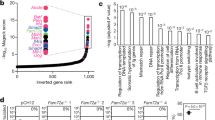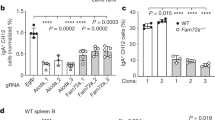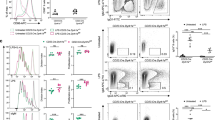Abstract
A functional immune system depends on the production of a wide range of immunoglobulin molecules. Immunoglobulin variable region (IgV) genes are diversified after gene rearrangement by hypermutation. In the DNA deamination model, we have proposed that deamination of dC residues to dU by activation-induced deaminase (AID) triggers this diversification. In hypermutating chicken DT40 B cells, most IgV mutations are dC → dG/dA or dG → dC/dT transversions, which are proposed to result from replication over sites of base loss produced by the excision activity of uracil-DNA glycosylase. Blocking the activity of uracil-DNA glycosylase should instead lead to replication over the dU lesion, resulting in dC → dT (and dG → dA) transitions. Here we show that expression in DT40 cells of a bacteriophage-encoded protein that inhibits uracil-DNA glycosylase shifts the pattern of IgV gene mutations from transversion dominance to transition dominance. This is good evidence that antibody diversification involves dC → dU deamination within the immunoglobulin locus itself.
This is a preview of subscription content, access via your institution
Access options
Subscribe to this journal
Receive 51 print issues and online access
$199.00 per year
only $3.90 per issue
Buy this article
- Purchase on Springer Link
- Instant access to full article PDF
Prices may be subject to local taxes which are calculated during checkout



Similar content being viewed by others
References
Petersen-Mahrt, S. K., Harris, R. S. & Neuberger, M. S. AID mutates E. coli suggesting a DNA deamination mechanism for antibody diversification. Nature 418, 99–103 (2002)
Muramatsu, M. et al. Specific expression of activation-induced cytidine deaminase (AID), a novel member of the RNA-editing deaminase family in germinal center B cells. J. Biol. Chem. 274, 18470–18476 (1999)
Lindahl, T. Suppression of spontaneous mutagenesis in human cells by DNA base excision-repair. Mutat. Res. 462, 129–135 (2000)
Lindahl, T. An N-glycosidase from Escherichia coli that releases free uracil from DNA containing deaminated cytosine residues. Proc. Natl Acad. Sci. USA 71, 3649–3653 (1974)
Takata, M. et al. Chromosome instability and defective recombinational repair in knockout mutants of the five Rad51 paralogs. Mol. Cell. Biol. 21, 2858–2866 (2001)
Sale, J. E., Calandrini, D. M., Takata, M., Takeda, S. & Neuberger, M. S. Ablation of XRCC2/3 transforms immunoglobulin V gene conversion into somatic hypermutation. Nature 412, 921–926 (2001)
Lindahl, T. Instability and decay of the primary structure of DNA. Nature 362, 709–715 (1993)
Pearl, L. H. Structure and function in the uracil-DNA glycosylase superfamily. Mutat. Res. 460, 165–181 (2000)
Nilsen, H. et al. Uracil-DNA glycosylase (UNG)-deficient mice reveal a primary role of the enzyme during DNA replication. Mol. Cell 5, 1059–1065 (2000)
Haushalter, K. A., Todd Stukenberg, M. W., Kirschner, M. W. & Verdine, G. L. Identification of a new uracil-DNA glycosylase family by expression cloning using synthetic inhibitors. Curr. Biol. 9, 174–185 (1999)
Nilsen, H. et al. Excision of deaminated cytosine from the vertebrate genome: role of the SMUG1 uracil-DNA glycosylase. EMBO J. 20, 4278–4286 (2001)
Friedberg, E. C., Ganesan, A. K. & Minton, K. N-glycosidase activity in extracts of Bacillus subtilis and its inhibition after infection with bacteriophage PBS2. J. Virol. 16, 315–321 (1975)
Wang, Z. & Mosbaugh, D. W. Uracil-DNA glycosylase inhibitor of bacteriophage PBS2: cloning and effects of expression of the inhibitor gene in Escherichia coli. J. Bacteriol. 170, 1082–1091 (1988)
Karran, P., Cone, R. & Friedberg, E. C. Specificity of the bacteriophage PBS2 induced inhibitor of uracil-DNA glycosylase. Biochemistry 20, 6092–6096 (1981)
Mol, C. D. et al. Crystal structure of human uracil-DNA glycosylase in complex with a protein inhibitor: protein mimicry of DNA. Cell 82, 701–708 (1995)
Handa, P., Roy, S. & Varshney, U. The role of leucine 191 of Escherichia coli uracil DNA glycosylase in the formation of a highly stable complex with the substrate mimic, Ugi, and in uracil excision from the synthetic substrates. J. Biol. Chem. 276, 17324–17331 (2001)
Radany, E. H. et al. Increased spontaneous mutation frequency in human cells expressing the phage PBS2-encoded inhibitor of uracil-DNA glycosylase. Mutat. Res. 461, 41–58 (2000)
Harris, R. S., Sale, J. E., Petersen-Mahrt, S. K. & Neuberger, M. S. AID is essential for immunoglobulin V gene conversion in a cultured B cell line. Curr. Biol. 12, 435–438 (2002)
Baba, T. W., Giroir, B. P. & Humphries, E. H. Cell lines derived from avian lymphomas exhibit two distinct phenotypes. Virology 144, 139–151 (1985)
Buerstedde, J. M. et al. Light chain gene conversion continues at high rate in an ALV-induced cell line. EMBO J. 9, 921–927 (1990)
Harris, R. S., Croom-Carter, D. S., Rickinson, A. B. & Neuberger, M. S. Epstein–Barr virus and the somatic hypermutation of immunoglobulin genes in Burkitt's lymphoma cells. J. Virol. 75, 10488–10492 (2001)
Acknowledgements
We thank R. Savva for the Ugi cassette, S. Takeda for XRCC2-deficient DT40 cells, R. Grenfell for help with cell sorting, and R. Harris, S. Petersen-Mahrt, C. Rada and J. Sale for discussions. J.D.N. was supported by a César Milstein fellowship and the Fundación Antorchas, Argentina.
Author information
Authors and Affiliations
Corresponding author
Ethics declarations
Competing interests
The authors declare that they have no competing financial interests.
Supplementary information
Rights and permissions
About this article
Cite this article
Di Noia, J., Neuberger, M. Altering the pathway of immunoglobulin hypermutation by inhibiting uracil-DNA glycosylase. Nature 419, 43–48 (2002). https://doi.org/10.1038/nature00981
Received:
Accepted:
Published:
Issue Date:
DOI: https://doi.org/10.1038/nature00981
This article is cited by
-
FAM72A antagonizes UNG2 to promote mutagenic repair during antibody maturation
Nature (2021)
-
Genome editing with CRISPR–Cas nucleases, base editors, transposases and prime editors
Nature Biotechnology (2020)
-
Synthesis, characterization and application of a novel nanorod-structured organic–inorganic hybrid material as an efficient catalyst for the preparation of aminouracil derivatives
Research on Chemical Intermediates (2020)
-
The KT Jeang Prize 2019: Reuben S. Harris
Retrovirology (2019)
-
Synthesis of aminouracil-tethered tri-substituted methanes in water by iodine-catalyzed multicomponent reactions
Molecular Diversity (2019)
Comments
By submitting a comment you agree to abide by our Terms and Community Guidelines. If you find something abusive or that does not comply with our terms or guidelines please flag it as inappropriate.



